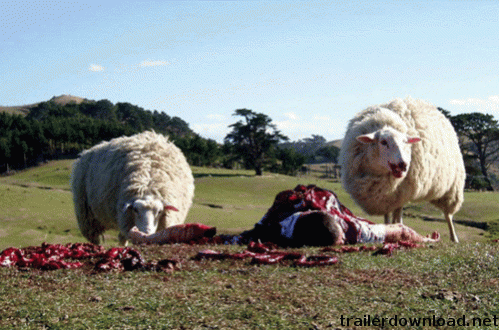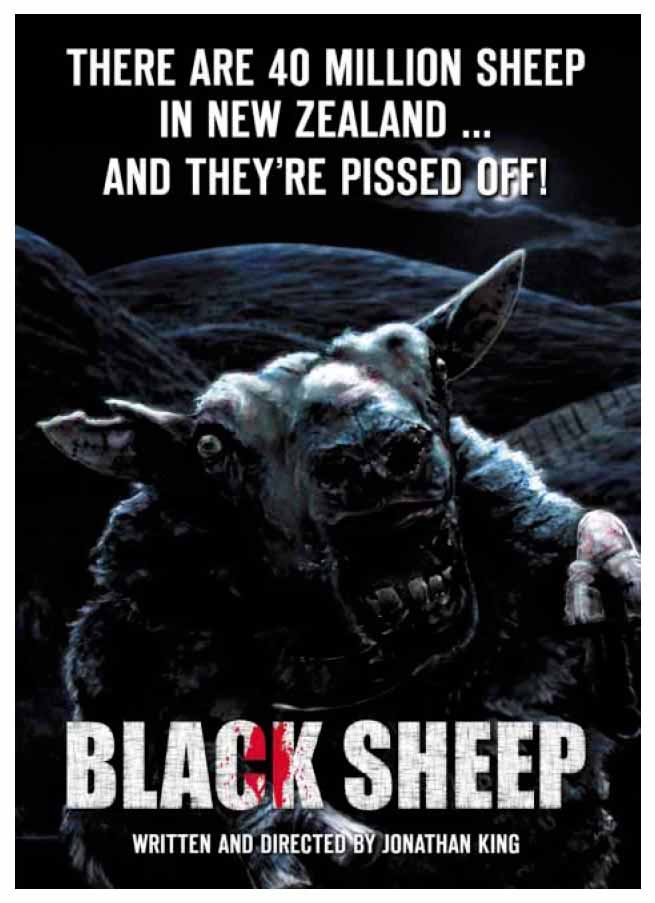“Bleating and babbling we fell on his neck with a scream/Wave upon wave of demented avengers march cheerfully out of obscurity into the dream…”
– “Sheep” by Roger Waters.
Most entries in the “killer animal” film sub-genre play upon the fears or revulsions of mankind. This one plays upon his guilt. Few animals are, after all, so consistently used and abused by that other animal known as Homo sapiens as the humble ovine. So there is something deep down satisfactory about BLACK SHEEP, in which these put-upon animals finally get the chance to turn upon their tormentors and deliver a little karmic justice. And it is only right and fitting that this film should emanate from the one country on earth that has more reason than any other to offer an apology to its woolly inhabitants: New Zealand.
BLACK SHEEP opens with a sequence as traumatic for the viewer as it is for the young Henry Oldfield, as he is subjected to a joke, using the term loosely, perpetrated by his bitter older brother, Angus, which involves the bloody demise of Henry’s pet sheep, only moments before both boys learn of the death of their father. Fifteen years later, the psychologically scarred Henry (Nathan Meiser) returns to the family farm on the advice of his therapist, looking for closure and intending to sell his interest in the family business to Angus (Peter Feeney), now an agricultural scientist determined to create the ultimate breed of sheep. Unfortunately for Henry – and everyone else within a wide radius – he is not the property’s only visitor. Activists Experience (Danielle Mason) and Grant (Oliver Driver) are on the premises unlawfully, hoping to obtain evidence of what they believe to be illegal experiments on sheep conducted by Angus and a scientist in his employ, Dr Rush (Tandi Wright). Grant manages to steal a glass canister marked “For Disposal”, but as he and Experience flee from Angus’s men, he drops it. The shattered canister releases a foetal sheep that immediately takes a bite out of Grant’s ear. The experimental animal then crawls away to a nearby paddock, where it also bites a normal sheep. Circumstances bring Henry, station manager Tucker (Tammy Davis) and Experience to a farmer’s shack, where they find the owner dead and mutilated. The next moment they are under siege from crazed, blood-lusting sheep. As the three are forced to fight for their lives, their efforts are hampered by Henry’s overpowering ovinophobia: a state he defines for his bewildered companions as “The completely unfounded and irrational fear that one day – THIS would happen!”
To deal frankly with what is at once BLACK SHEEP’s greatest strength and greatest weakness, this is essentially a one-joke film; how much enjoyment the viewer gets out of it will be dictated by how funny he or she finds that joke. The sheer ludicrousness of the premise does carry the production a fair distance. Flesh-eating zombie sheep, rampaging half-human were-sheep, genetically engineered mutant sheep, even a truck-driving sheep – If you can sit through all of this without a goofy grin on your face, well, you’re not the kind of person I want to watch a movie with. However, it is true enough that the film never travels much beyond this point. There was room for a deeper satire in BLACK SHEEP, but nothing like that ever eventuates; the sheep are genetically engineered not because the film is interested in debating the ethics of such techniques, but simply because “genetic engineering” is to the twenty-first century science fiction film what “radiation” was to those of the twentieth.
Of course, no film – least of all one about mutant killer sheep – is obliged to “say something”; so rather than criticise this production for its profound disinterest in anything that doesn’t involve grossing out its audience, it would be more to the point to commend it for the energy it puts into achieving that one great goal. Mutilated human bodies abound in Black Sheep: the camera lingers with glee over disembowellings, throat tearings, limb severings and, in the case of Angus Oldfield’s inevitable demise, genital violence guaranteed to bring tears to the eyes of any male viewer.
It is only fair to post a warning that not all of the mayhem in this film is perpetrated upon members of the human race. If you’re anything like me, and find violence against animals, even obviously faked violence, far more distressing than its human equivalent, there are a number of scenes here that will have you covering your eyes in horror. (In fact, if Black Sheep could be said to have any kind of message, it would be that while it’s bad enough to be a sheep in New Zealand, it really sucks to be a rabbit.) Much of this film’s humour is predicated upon the simple juxtapositioning of acts of extreme violence with their supposed commission by that most unthreatening of animals, Ovis aries. For me, the absolute highlight is a shot of quite pastoral beauty, with green hills in the background and, in the foreground, sheep grazing peacefully upon the bloody remains of a dismembered human being. The composition is so perfect, it is guaranteed to warm the cockles of your heart. Or at any rate, the cockles of my heart.

It is safe to say that there is no possible sheep joke that doesn’t find its way in front of the camera in BLACK SHEEP. Mint sauce acts like holy water; an antidote for were-sheep-ism, when discovered, is administered in the form of a drench; and although the human characters are powerless to stop it, a berserk were-sheep is brought to bay by the eye of an ordinary sheep-dog. The film’s idea of what a “genetic engineering lab” might look like is, intentionally or otherwise, simply hilarious, as indeed is the wardrobe of choice of its rogue scientist, Dr Rush, who while occupying a sheep farm in the middle of sunny New Zealand, opts to dress in gleaming white pant-suits and spike heels.
However, probably to no-one’s surprise, the bulk of the non-violent humour in this film is focused upon what we have to call, not just “a” New Zealand sheep joke, but “THE” New Zealand sheep joke – and here, too, the sheep is given the opportunity to revenge itself upon mankind when Henry, somewhat inadequately disguised in a covering of sheepskin car seat covers, attracts the attention of a horny ram. After this, there is a certain inevitability about the revelation of Angus’s relationship with his experimental sheep. But don’t think that BLACK SHEEP has hit the bottom of the barrel just yet – if you’ll excuse the use of the word “bottom” in this context. What would a gross-out comedy be, after all, without fart jokes? And BLACK SHEEP isn’t content just to make a fart joke or two; oh, no; instead, it builds its climactic scene around what might just be the fart joke to end all fart jokes. (Quoth Experience: “Methane….”)
The screenplay is rarely more than adequate. The characters are all stock and, while they’re amusing, they’re also fairly one-note. As with many New Zealand films, BLACK SHEEP evinces a degree of suspicion about anyone or anything that is remotely citified. Thus, while Tucker, the Maori station manager, is largely exempt from criticism, almost everyone else takes a severe pounding. Even Henry, our nominal hero, is rigorously punished for his initial self-absorption. Thankfully, this film refrains from falling into the same trap as one of its obvious models, MAN’S BEST FRIEND. It may be Angus and Dr Rush who have developed the ovine horror, but it is Experience and Grant who let it loose; and the film slaps at both sides of this ethical divide with equal gusto. BLACK SHEEP’s use of its locations is a real strength, highlighting the gorgeous New Zealand landscape without ever feeling like a travelogue. Indeed, in this respect the film deliberately and shrewdly undermines itself: Experience pauses on a cliff edge to admire the stunning view, only to be told that this is where Henry’s father fell to his death.
Screenplay, locations, cinematography – Pah! What we’re here for is the killer sheep, right? The special effects in this film are a bit of a mixed bag. The body-part effects are generally convincing, the sheep themselves somewhat less so – although undoubtedly, a lot of the goofiness is completely intentional. There is some CGI on display here, but its use is limited, mostly confined to some of the human-sheep transformation scenes, and to the stampede sequences. The killer sheep effects are predominantly mechanical, achieved through puppeteering and animatronics, and it is to this that most of this film’s idiotic charm can be credited.
It is clear thatBLACK SHEEP’s writer-director Jonathan King knows and understands his roots. Spiritually – spiritually!? – this film’s main inspiration is the early work of Peter Jackson, those home-made splatter films, BAD TASTE and BRAINDEAD; but numerous other genre films rate a reference, too. We have, for instance, the inevitable NIGHT OF THE LIVING DEAD siege sequence; the best mass-slaughter-of-a-social-gathering since ALLIGATOR; and a transformation scene modelled squarely on the centrepiece of AN AMERICAN WEREWOLF IN LONDON. Alas, BLACK SHEEP’s budget didn’t allow for the full extravaganza, but those jutting sheep’s jaws bring a fond smile to the face, just the same. This is certainly a work intended to appeal to those who know and love their killer animal films; who get a nasty thrill out of watching humankind being done unto as it generally does unto others. It’s not great; it’s not original; and it certainly isn’t art. But then, who wants art all the time? As an hour and a half of dumb, disgusting fun, BLACK SHEEP can’t be bleat (ahem).
BLACK SHEEP (Live Stock Films, 2006). Written and directed by Jonathan King. Cast: Nathan Meister, Danielle Mason, Peter Feeney, Tammy Davis, Glenis Levestam, Tandi Wright, Oliver Driver, Mathew Cahmberlain.
